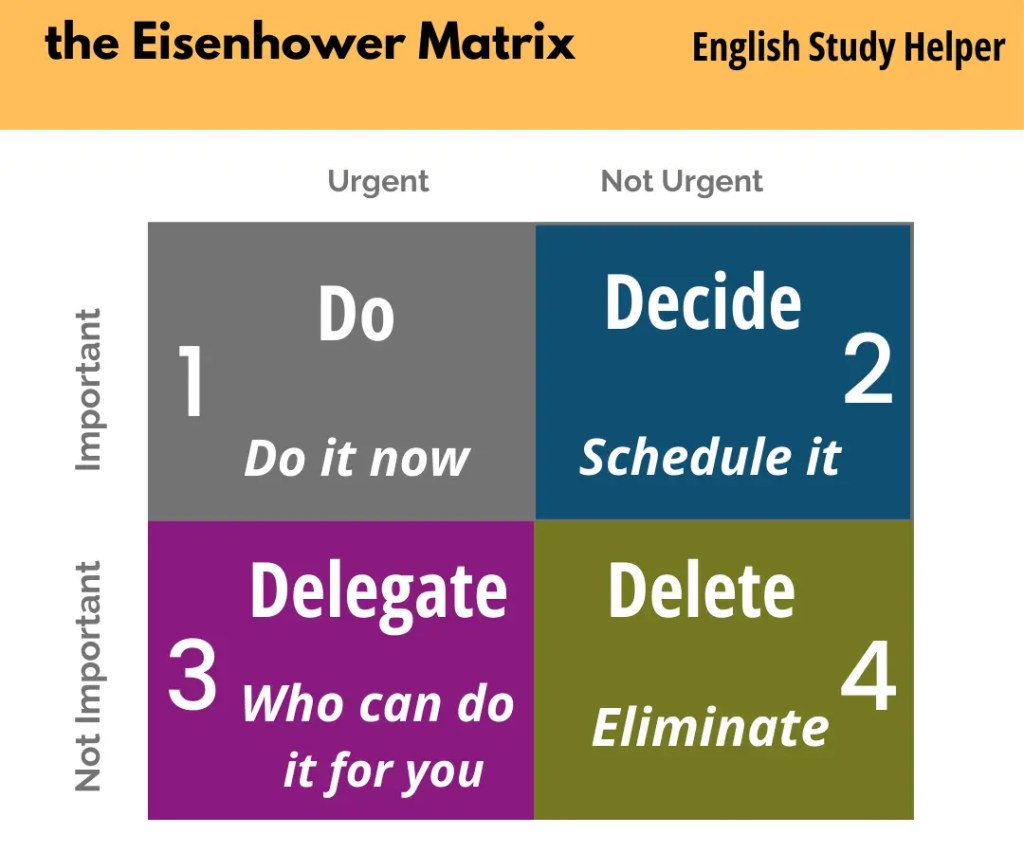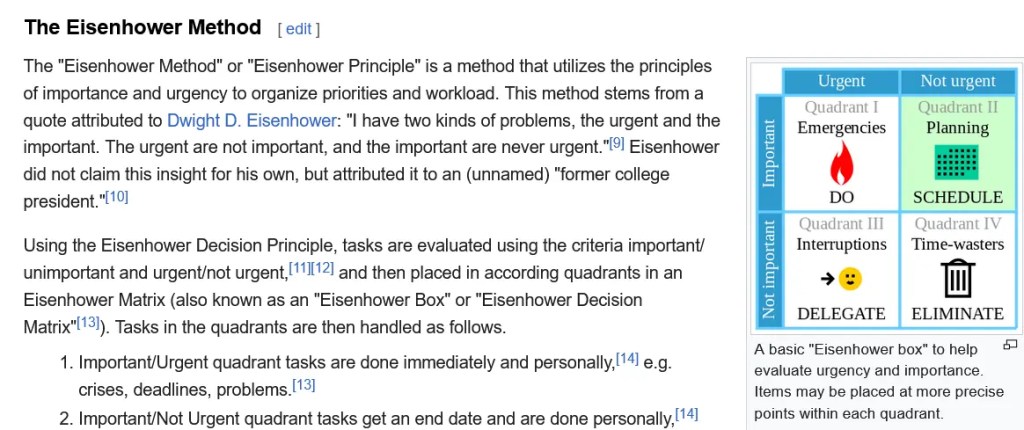Eisenhower Matrix for Time Management and Better Learning Efficiency
What is the Eisenhower Matrix for Time Management, and how can this method help improve learning efficiency?
Have you ever felt so swamped with tasks that you didn’t know where to start?
Like you’re juggling flaming torches while riding a unicycle on a tightrope?
It’s that moment when your to-do list is so long it feels like it’s laughing at you.
Trust me, I’ve been there, staring at my desk like a deer in headlights, wondering which task to tackle first.
The Eisenhower Matrix has completely transformed how I manage my time and focus on what matters.
After starting to sort tasks into urgent and important categories, I've been able to prioritize better and avoid the stress of last-minute rushes.
One thing that surprised me was how dedicating time to important but not urgent tasks, like planning and learning new skills, has greatly impacted my long-term success.
What Is the Eisenhower Matrix for Time Management

The Eisenhower Matrix, also known as the Urgent-Important Matrix, is a time management tool that helps prioritize tasks based on their urgency and importance.
Named after Dwight D. Eisenhower, the 34th President of the United States, who famously used this method to make decisions efficiently, the matrix divides tasks into four quadrants:
- Urgent and Important
- Not Urgent but Important
- Urgent but Not Important
- Not Urgent and Not Important
The Concept Behind It
Think of it like a four-room house, where each room has a specific purpose.
The Eisenhower Matrix works the same way, sorting tasks into four categories to help you decide what to tackle first.
Components of the Eisenhower Matrix

The matrix, or box, is divided into four quadrants with “important” and “not important” on the vertical axis and “urgent” and “not urgent” on the horizontal axis.
When you see the term “important,” think of it as tasks that are crucial for your goals or require your specific skills.
Sometimes, a task might be important for your goals, but it doesn't have to be done by you.
Keep reading, and I'll explain this further in a minute.
Quadrant 1
Tasks are the ones that need your attention right now and are vital for your success.
Think of meeting deadlines, tackling emergencies, and dealing with critical problems.
These are the high-pressure situations where swift action is crucial.
So, when something falls into this category, prioritize it immediately to keep things on track and avoid bigger issues down the road.
For language learners, Quadrant 1 tasks might include:
Studying for an upcoming language exam
If you have a test in a few days, it's crucial to focus on reviewing vocabulary, practicing grammar exercises, and doing practice tests.
This is urgent and important because your exam is imminent, and your performance can significantly impact your language learning progress.
Preparing for a job interview in a new language
If you have a job interview soon where you need to demonstrate your language skills, you should immediately focus on practicing common interview questions, refining your pronunciation, and brushing up on industry-specific vocabulary.
This preparation is essential for making a good impression and advancing your career.
Quadrant 2
Tasks are those that are important for your long-term success but don’t need to be done right away.
These tasks include planning, strategizing, and personal development activities like setting goals, learning new skills, and building relationships.
This proactive approach helps you grow, improve, and prepare for upcoming challenges, ensuring you achieve lasting success.
For language learners, Quadrant 2 tasks might include:
Setting long-term language learning goals
Spend time defining what you want to achieve, such as becoming fluent in a year or being able to read a novel in English.
This planning is crucial for your long-term success, but doesn’t require immediate action, allowing you to work towards your objectives steadily.
Building relationships with native speakers:
Invest in creating connections through language exchange programs, joining conversation groups, or finding a language buddy.
These activities help you practice and improve your language skills over time, fostering a deeper understanding and fluency without the pressure of immediate deadlines.
Quadrant 3
Tasks are those that require your immediate attention but don't significantly impact your long-term goals.
These tasks can often be delegated or minimized.
Examples include attending specific meetings that aren't crucial to your progress or responding to non-critical emails.
For language learners, Quadrant 3 tasks might include:
Responding to non-essential language practice app notifications
While these notifications might urge you to complete a quick lesson or activity right away, they don't significantly impact your overall language learning progress and can often be done later.
Attending optional language club meetings
These meetings might be interesting and provide some practice. Still, if they're not directly contributing to your immediate learning goals or improvement areas, they can be minimized or skipped when you're pressed for time.
Quadrant 4
Quadrant 4 tasks are neither urgent nor important.
These tasks often serve as distractions or time-wasters, like browsing social media or watching TV.
They don’t contribute to your goals or long-term success, and they aren’t time-sensitive.
Ideally, you should minimize or eliminate these activities to better use your time and focus on more productive tasks.
For language learners, Quadrant 4 tasks might include:
Mindlessly scrolling through social media feeds
Spending excessive time on social media doesn't directly contribute to language learning progress and can detract from valuable study time.
Watching TV shows or movies in the native language without actively engaging
While watching content in the target language can be beneficial, passively consuming it without actively listening or practicing comprehension skills doesn't contribute significantly to language improvement.
What are the benefits of the Eisenhower Matrix

- Improved Prioritization
- Enhanced Decision-Making
- Increased Productivity
- Stress Reduction
- Better Long-Term Planning
- Delegation Skills
- Minimized Distractions
- Balanced Workload
I could list more reasons, but I think the ones I've mentioned are enough to give you an idea and make you consider trying this method.
How to implement the Eisenhower Matrix
Implementing the Eisenhower Matrix is simple and can be done in a few steps:
Step 1: Draw the Matrix: Draw a square and divide it into four smaller squares, creating a 2×2 grid. Label the rows and columns to create four quadrants:
- Top left: Urgent and Important
- Top right: Not Urgent but Important
- Bottom left: Urgent but Not Important
- Bottom right: Not Urgent and Not Important
Step 2: List Your Tasks: Write down all the tasks you need to complete. Be thorough and include everything you can think of.
Step 3: Categorize Your Tasks: Place each task into one of the four quadrants based on its urgency and importance:
- Quadrant 1 (Urgent and Important): Tasks that need immediate attention and are crucial for achieving significant goals, like meeting deadlines or handling crises.
- Quadrant 2 (Not Urgent but Important): Tasks that are important for long-term success but don’t require immediate action, such as planning, goal setting, and personal development.
- Quadrant 3 (Urgent but Not Important): Tasks that require immediate attention but don’t contribute significantly to long-term goals, like responding to non-critical emails or attending certain meetings.
- Quadrant 4 (Not Urgent and Not Important): Tasks that are neither time-sensitive nor crucial to your goals, such as browsing social media or watching TV.
Step 4: Prioritize Your Tasks:
- Focus on Quadrant 1: These tasks are your top priority because they are both urgent and important.
- Schedule Time for Quadrant 2: These tasks are important for your long-term success, so make sure to allocate time for them regularly.
- Minimize or Delegate Quadrant 3: If possible, delegate these tasks to others or find ways to minimize them.
- Eliminate Quadrant 4: These tasks are distractions and should be reduced or eliminated.
- Review and Adjust Regularly: Periodically review your matrix and adjust your tasks as needed. This will help you stay on track and ensure you’re focusing on what matters most.
.
Criticisms
Too Rigid
The matrix can be too rigid, and life isn’t always that simple. Some tasks might not fit neatly into any category.
Overthinking
It's easy to overthink things and get stuck. Don’t let the matrix become just another thing that makes you feel overwhelmed.
Alternatives to the Eisenhower Matrix
ABCDE Method
Prioritize tasks from A to E based on their importance and urgency.
The Pomodoro Technique
A time-management method that encourages working in short bursts to improve focus. Learn the Pomodoro Technique.
Related reads:
25 + Easy Ways to Boost Your Language Learning Productivity
How to Use The Mirror Technique for Language Mastery
Time Audit: Tried-and-True Tool to Be Productive & Learn English Faster
The Pomodoro Technique: How to Use It For Productivity
How to Learn English Faster with The 2-Minute Rule
ADHD-friendly apps for learners: The best Tool – Sunsama
If you need more tips and guidance to grow your language learning skills, be productive, and reach real progress, explore my membership, which offers courses, guides, and resources.
Feel free to come and say hi on my Facebook group!
Conclusion: Eisenhower Matrix for Time Management and Better Learning Efficiency
I highly recommend the Eisenhower Matrix for time management and better learning efficiency.
It helps you align your tasks with your goals, cutting out those tempting but unproductive activities (and believe me, I love shiny things too!).
Focusing on what truly matters, you become more efficient and can better balance your learning goals and personal life.
Your next step is to sit down and follow the implementation steps, then spend two weeks using this method to see how it works for you.
Thanks for reading,
M.K









